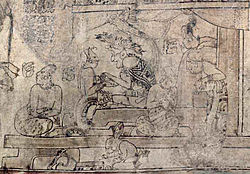Category:Princeton Vase
| Princeton Vase
|
||
|---|---|---|
| Artist |
Unknown, Late Classic, Maya ('Codex' style) |
|
| Title |
The Princeton Vase |
|
| Object type | vase | |
| Description |
On this side of the famous Maya chocolate-drinking cup known as the Princeton Vase, an old, toothless underworld god sits on a throne within a palace, represented by the pier behind him and a cornice above. Curtains, which were used as doors among the ancient Maya, have been pulled up to reveal the interior scene. This deity, known among scholars as God L, wears his characteristic shawl and a broadbrimmed hat bedecked with owl feathers and an owl. In addition to ruling the Maya underworld, God L was the patron deity of tobacco and merchants. Five elegant female figures—possibly concubines— surround him. A rabbit scribe, who might be spying on God L, sits below, writing in a book. A standing woman with her head bent in concentration suggests that the viewer rotate the vase to the left. She holds a vessel similar in size and shape to the Princeton Vase, and a stream of liquid pours down from it, presumably into a vessel whose rendering has eroded. This method of preparation likely frothed the bitter chocolate beverage that this vessel was made to serve. The vertical pier or rear wall of a palace structure marks the boundaries of the overall composition on this vase, placing the selfreferential vignette of vessel use at the end of the scene, as a sort of addendum. The most important moment in the narrative of the Princeton Vase appears on this side of the vessel. Two men wearing elaborate masks and wielding axes decapitate a bound and stripped figure, seen at the lower left; the victim’s serpent-umbilicus curls out to bite one of the executioners. The scene closely parallels a portion of the Popol Vuh, a sixteenth-century K’iche’ Maya mythological narrative in which the Hero Twins trick the lords of the underworld into requesting their own decapitations. As is common in mythological narratives throughout the Americas, these heroes win the day not through feats of brute strength but through cunning, and often humorous, trickery. With graceful, sure lines painted on a cream slip, the Princeton Vase presents a story that stretches around the entire object. Because passing or turning the drinking cup is necessary for full comprehension of the narrative, subtle visual devices between the primary scenes encourage the viewer to rotate the vessel, creating a temporal unfolding of the visual experience. Here, for example, a young noblewoman taps the foot of the woman in front of her while turning her head in the opposite direction: she is between two scenes and encourages her companion (and thus the viewer) to shift her attention around the vase. |
|
| Date | A.D. 670–750 | |
| Medium | ceramic with red, cream, and black slip, with remnants of painted stucco | |
| Dimensions | height: 21.5 cm (8.4 in); diameter: 16.6 cm (6.5 in) | |
| Collection | Princeton University Art Museum | |
| Current location |
Art of the Ancient Americas |
|
| Accession number |
y1975-17 |
|
| Notes | K0511 MS1404 | |
| References |
|
|
| Upload media | |||||
| Instance of | |||||
|---|---|---|---|---|---|
| Made from material | |||||
| Diameter |
| ||||
| Height |
| ||||
| |||||
Media in category "Princeton Vase"
The following 2 files are in this category, out of 2 total.
-
God L with the Hero Twins.jpg 700 × 486; 240 KB
-
Maya vase.jpg 1,199 × 582; 422 KB



